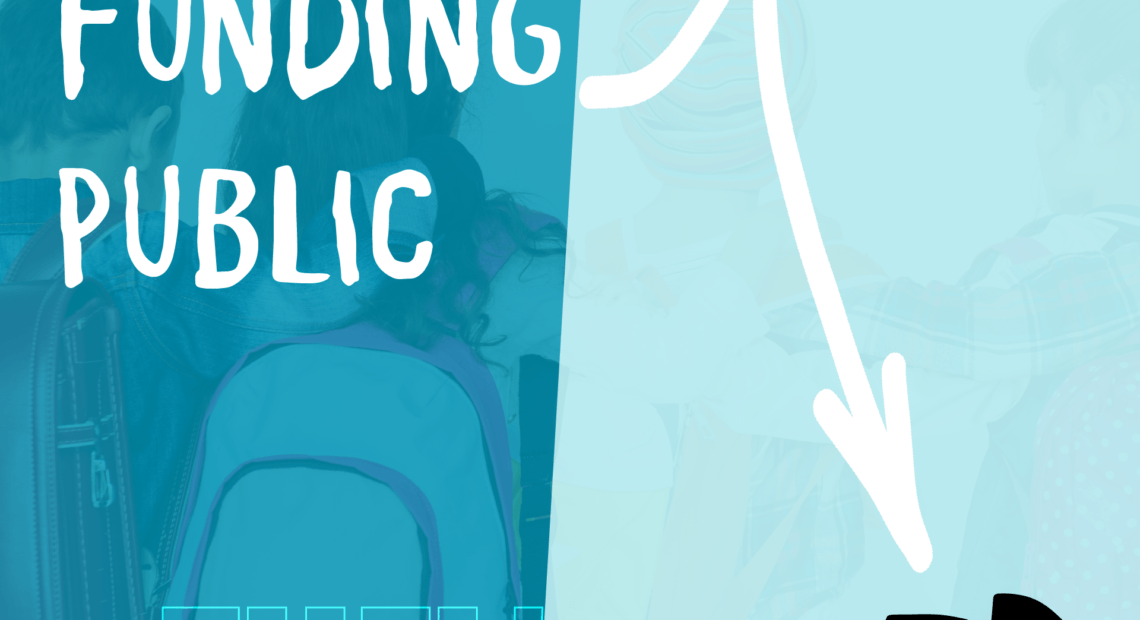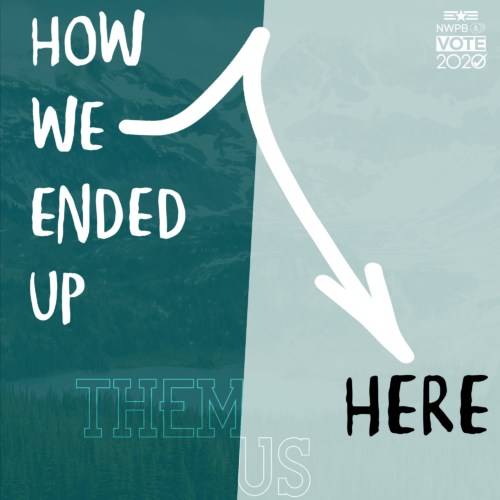Episode 1 – Funding Public Education Transcript
EPISODE 1 – FUNDING PUBLIC ED
On this episode…the funding of public education in Washington state ahead of the special election on February 11th.
Hosted and produced by Kanale Rhoden
MUSIC
KANALE: From Northwest Public Broadcasting. I’m Kanale Rhoden, and this is how we ended up here on this episode, the funding of public education in Washington state ahead of the special election on February 11th the inequity in funding is still there. I would also say not only is still there but is greater than it was before. The funding of public education in Washington state is not perfect, nor is it a science.
MUSIC
KANALE: In fact, it’s hard to wrap your head around exactly how funds are calculated and it’s hard to understand how some schools receive additional funding from the state. I visited with Dr. Bob Maxwell, Superintendent from the Pullman School District last week to try and figure it all out.
KANALE ((IN OFFICE)):
So before we talk about the really easy part of the conversation of public funding and education, right? Very simple. Really. Can we just chit chat maybe about the Bob story? You’ve been in Pullman for seven years and the last four have been the superintendent of the Pullman school district.
BOB: Happy to do that. Seven years ago, I saw that there was a job opening for an assistant superintendent where Pullman Public Schools. At the time I was the executive director of special services and the Bethel school district on the west side. And uh, I was interested in a change. I had also, um, received my doctorate in educational administration from WSU and, uh, I was really excited about the opportunity, uh, to come to Pullman. My connection with WSU and my excitement to come to a different district and a little bit smaller was, uh, the driving force behind that.
KANALE: We eventually got around to school funding. I started off by asking how it all works, how the state of Washington funds public education.
BOB: Washington state’s current funding model is based on what they call the prototypical model. And what that is, is a fixed theoretical school size use for modeling purposes as enrollment increases or decreases from the prototypical size, the staff units, uh, change proportionately.
MUSIC UNDER
KANALE: Okay. Here’s the breakdown. According to the state quote, “prototypical schools illustrate the level of resources needed to operate a school of a particular size with particular types and grade levels of students.” End quote funding is based on what the state perceives as a typical school in Washington state. A typical elementary school in Washington state, around 400 students…
MUSIC ENDS
BOB …a middle school, 432 in a high school, 600 students. Well, that’s just a typical, most schools are much, much larger than that.
KANALE: So you take a typical elementary school, middle school, and high school, add those all up. The state says an average district in Washington state is around 1,400 students. So funding for schools is based on how much it would cost operationally run a district of about 1400 students using this model. The current base rate for the current school year 2019/2020 was set at just about $8,500, $8,511.62 cents per student to be exact.
Last year, the Pullman school district had around 2,800 students, K through 12, that’s about 1,400 more students than a prototypical school district. According to Washington state, the base allocation for the Pullman school district was just around $25 million. On the surface, that looks fine, but diving deeper into their budget, it appears that expenditures totaled nearly $35 million. This, according to Dr. Bob Maxwell is where local bonds and levies come into help. They help to fill that $10 million gap from state and federal funding for the Pullman school district bond.
BOB: It can only be used for building. So those funds that are generated for a bond can only be used for a building renovation expansion. Levy dollars can be spent on extracurricular activities, um, extended school days, additional course offerings, additional staff, administration of enrichment activities.
KANALE: So, throw another wrench in there. Not all schools receive the same funding from the state. They all receive the same base allocation funding, but some schools receive special funding, additional funding called regionalization.
BOB: So, uh, if you’re a district that qualifies for regionalization dollars, you can receive anywhere from 6% additional to 24% additional on top of the state allocation. Um, in our region of 59 school districts on the East side, only two districts qualify for regionalization enhancement. Spokane and Mead, most of the other school districts that receive regionalization are on the West side. So, and you have a smattering in between, but um, that creates quite an inequity in teacher salaries.
KANALE: Do you see that impacting smaller school districts or rural school districts that potentially don’t get that additional funding to attract teachers to that area?
BOB: Absolutely. Um, you know, looking at a teacher that uh, let’s say graduating from WSU teaching program, let’s say they have a lot of debt. Let’s say we can offer a, I’m just making up. So let’s say we could offer them based on their experience, $45,000 to start. Seattle may be able to offer much, much more than that. Well, if you have debt, you’re probably going to go to Seattle. So it’s gonna make recruiting very, very challenging when other school districts are receiving more of this data allocation than we are under. That inequality of funding, uh, happened at [inaudible] is a great mystery to figure out. Number one, what the formula for regionalization of why some districts qualified and why others did not and why certain my limited understanding on the topic, it’s somewhat based off of housing prices, but that’s very challenging when you’re trying to attract and recruit. When you have a district not only gets the state allocation but they’re getting regionalization on top of it, that creates a challenge.
MUSIC
KANALE: So, here’s where we are. Washington state funds a base amount to school districts to help educate our students. This is based on how many students are in your district. Some districts again received special funding, additional funding called regionalization funds. All of these state funds, base allocation and special funds help districts pay for curriculum material, teacher salaries and operational costs. The base funds provided by the state do not necessarily account for how each district operates. Again in Washington, it’s based on a typical school district. More on that after this.
MUSIC FULL
UNDERWRITING MESSAGE
HANNAH: This episode of How We Ended Up Here is supported by members of Northwest Public Broadcasting. If you’ve ever watched a construction crew pour a foundation for a home or office, you realize how important that concrete base is. It’s what gives the building its stability like that. Concrete monthly supporters provide a strong foundation for Northwest public broadcasting. Dollar by dollar. Your donations are an ongoing and reliable income that pays for all your favorite programs and podcasts. Become a monthly supporter for just five or $10 a month. You’ll be rewarded by knowing your contribution is the summit that makes NWPB be your home for your favorite programs. Join today at NWPB.org
MUSIC FULL
PODCAST CONTINUES – THEME MUSIC
KANALE: Welcome back. We’re talking about public school funding in Washington state as we head towards the February 11th special elections. Dr. Bob Maxwell, Pullman School District Superintendent, continues to explain how levies help bridge budget gaps from the state-based allocation for public schools.
BOB: Right now, the state gives us enough allocation for approximately a half time school nurse. Currently right now we have four full time nurses to serve. Our student population only receives half funding from the state. We only receive half of one position and we have four full time positions. So the other 3.5 positions are funded out of those local levy dollars, we don’t receive any state money for those positions. And that’s just one example. Custodians would be another teachers would be another on many of the teachers that we have are state funded, but some are not. Some are funded with levy dollars. If you look at the Chromebook carts that you’ll see in every one of our schools, that’s a lot of the hardware. A lot of the software programs that students utilize are also paid out for those funds. Um, also some of those funds are used for servers so we can operate and you can see also cameras and I think just a lot of student projects you’re able to see whether it’s uh, videos or PowerPoints or um, word document. Uh, students are very, very much a technology savvy.
KANALE: A lot of cities and districts around the state are maybe on tax fatigue. Right. You have, bonds trying to be passed by hospitals or EMS or safety. What do you say about the education? In the state of Washington. And why special elections like this to help pass bonds and levies for school district?
BOB: So vital. One of the important things I think we need to remember with levies is that, uh, school districts do a lot of research and study before we go out and run a levy. We are aware sometimes that there’s tax fatigue in the, in the community, but I think that’s also shows the work that we’ve done is to make sure that we’re not asking for more per thousand. We’re actually accessing for less. And part of that is because of all the building that’s gone on in Pullman and that contributes to lowering those tax rates. And I think that’s important. What we’re going to get is a renovated school that provides a much better, uh, learning environment, a quality learning environment, and meets the needs of our community right now and in the future.
KANALE: Our thanks to Dr. Bob Maxwell of the Pullman school district. Special elections across Washington state happen on February 11th. For more information on ballots, polling locations, and other election related news. Visit nwpb.org/vote2020 the website again, nwpb.org/vote2020. For How We Ended Up Here, I’m Kanale Rhoden.










